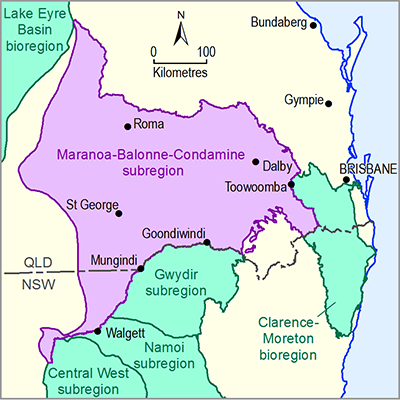The natural and human-modified ecosystems in the subregion were classified into 34 landscape classes to enable a systematic and comprehensive analysis of potential impacts on, and risks to, the water-dependent assets nominated by the community. The classes were aggregated into five landscape groups based on their likely response to hydrological changes. The landscape classification was based on the geology, geomorphology, hydrogeology, land use and ecology of the subregion. For further details, see Section 2.3.3 (companion product 2.3 for the Maranoa-Balonne-Condamine subregion (Holland et al., 2016)) and companion submethodology M05 (as listed in Table 1) for developing a conceptual model of causal pathways (Henderson et al., 2016).
Springs and groundwater bores may be affected by hydrological changes in deeper geological layers, which may have ecological repercussions for surface ecosystems surrounding springs. The source aquifer was identified using existing datasets (e.g. OGIA (Office of Groundwater Impact Assessment, Dataset 9, Dataset 10) or Queensland Department of Natural Resources and Mines (Bioregional Assessment Programme, Dataset 11)). Where this information was not available, the Assessment team assumed that the bores or springs access the shallowest geological layer in that assessment unit (i.e. the regional watertable). This differs from the assumption under the Queensland water planning framework that all management units underlying a discharge spring are considered to be connected to it. This assessment is not a substitute for detailed, site-specific assessment of projects and impacts under state or Commonwealth environmental law. Such assessments may use finer-scale groundwater and surface water models in order to assess local-scale impacts. The implications of the BA assumption are context specific and are addressed in Section 3.4 for landscape classes and in Section 3.5 for assets where appropriate and also by identifying it as a knowledge gap.
Receptor impact models were not built for the Maranoa-Balonne-Condamine subregion as part of prioritising effort across the entire Bioregional Assessment Technical Programme, but also because modelled hydrological change was limited to groundwater changes. Receptor impact models could, however, have an important role in translating the hydrological change, as measured by hydrological response variables, into receptor impact variables that may be considered better indicators of potential ecosystem change. For those landscape classes within the zone of potential hydrological change that are considered water dependent, the construction of receptor impact models would commence with the development of qualitative mathematical models through an expert consultation process and would produce signed-directed graphs of key system components and interactions. These signed-directed graphs would identify important hydrological response variables and receptor impact variables. A full description of the receptor impact modelling methodology is described in companion submethodology M08 (as listed in Table 1) for receptor impact modelling (Hosack et al., 2017).
The results of these analyses are summarised in this product, with more detailed information available on www.bioregionalassessments.gov.au. The impact analysis databases are also available on www.data.gov.au.

Product Finalisation date
- 3.1 Overview
- 3.2 Methods
- 3.3 Potential hydrological changes
- 3.4 Impacts on and risks to landscape classes
- 3.4.1 Overview
- 3.4.2 Landscape classes that are unlikely to be impacted
- 3.4.3 'Floodplain or lowland riverine (including non-GAB GDEs)' landscape group
- 3.4.4 'GAB GDEs (riverine, springs, floodplain or non-floodplain)' landscape group
- 3.4.5 'Non-floodplain or upland riverine (including non-GAB GDEs)' landscape group
- 3.4.6 'Human-modified' landscape group
- References
- Datasets
- 3.5 Impacts on and risks to water-dependent assets
- 3.6 Commentary for coal resource developments that are not modelled
- 3.7 Conclusion
- Citation
- Acknowledgements
- Contributors to the Technical Programme
- About this technical product
